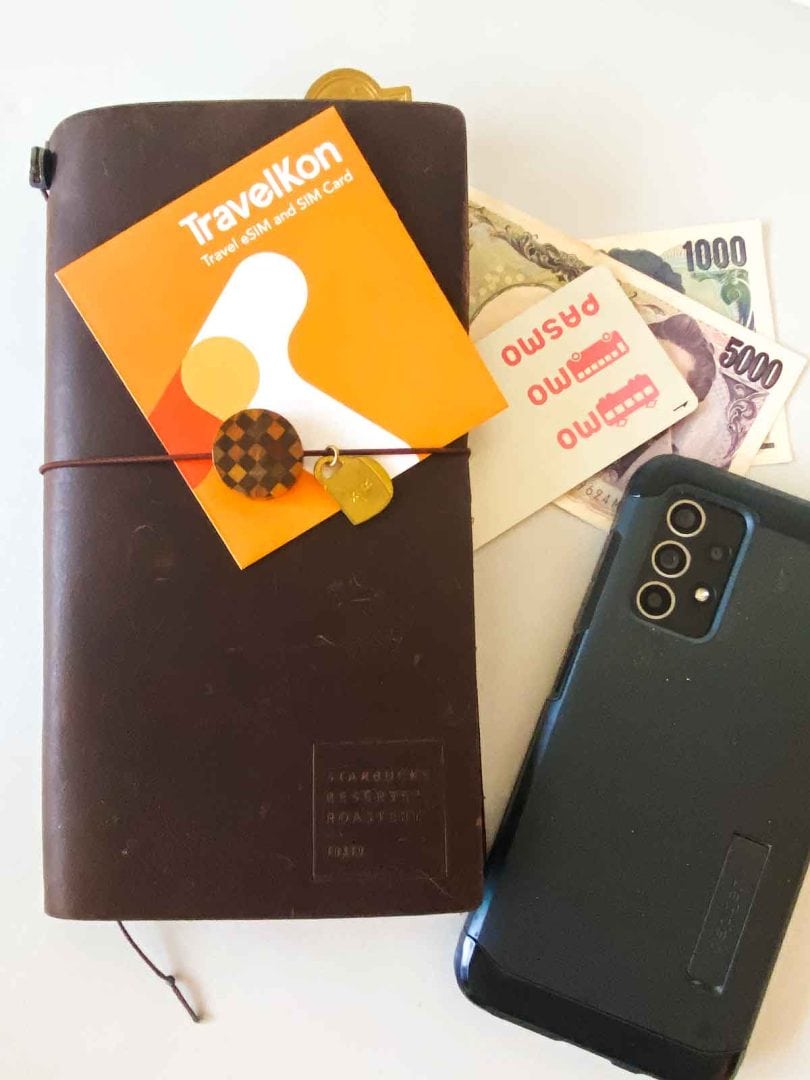When we travel to Japan, we find it incredibly useful to stay connected. Like many people, we have become reliant on the digital world in our everyday lives and even more when travelling. In Japan, we use apps for train schedules, walking maps, translation tools, and the ability to back up our photos and videos seamlessly to the cloud daily.
We have discussed the various internet options for tourists in Japan in the past, and each option has its pros and cons. On this trip, we decided to try a TravelKon SIM and see how that worked for us.

Table of Contents
Why we choose TravelKon SIM and eSIM for this trip
TravelKon is an Australian business, so that was attractive for us. We wanted a physical SIM for one of the cards, which would be dispatched locally and presumably get to us faster. We’d also be purchasing in our home currency, which is even more attractive now that most credit cards in Australia have recently rescinded their fee-free international transactions.
Other factors influencing our choice of TravelKon are that we could have the physical SIM and eSIM details before we left home so we could be connected quickly once we arrived without having to make an additional stop to collect them when arriving late in the evening. TravelKon also offers physical SIM and eSIM, which many providers don’t offer, so we can get it all sorted in one transaction.
We are larger data users than many travellers, mostly because we like to back up our photos and videos to the cloud as we go. We enjoy photography and like to know that our memories will be safely stored. We are also on and off the phone throughout the day checking maps, accessing digital tickets, translating menus and all the usual things.
TravelKon SIM and eSIM options for Japan and worldwide
If you decide to purchase, use this link for a 15% discount
Is having an internet connection really necessary?
When we started travelling in Japan regularly back in 2010, getting an internet connection wasn’t easy or affordable. I did as much planning as I could in advance. Hotels usually gave guests a small quantity of data, and a breakfast coffee at Starbucks became part of the routine. They had free and reasonably stable connections, so we could down a caffeine hit, quickly check what we needed to for the day, and then get going. Today, that just wouldn’t work for us.
An end-to-end connection
When choosing between the options, connectivity from when we land until we depart has become essential. We don’t want a WIFI router or SIM delivered to our hotel or have to make a detour when we land to collect them. We want them in our bag when we leave home and installed and ready to go when we step off the plane and into the airport. This has become the deal breaker for us when choosing internet connectivity solutions for travelling with mobile routers and SIM technology.
TravelKon sent the eSIM details instantly; the SIM card only took a few days to arrive through the post. Another advantage of TravelKon is that you have 90 days from purchase to activate and use it rather than being locked to a specific start and end date.
A SIM or eSIM
The choice between a physical SIM and an eSIM when travelling will depend on two factors: your phone and personal preference. Most newer model phones will have the eSIM option, but not all. We were surprised when we checked before this trip to find Drew’s Samsung didn’t take eSIM, so that made his decision easy.
I prefer an eSIM. I don’t need to find somewhere safe to put the tiny SIM card, so I don’t lose it, and when I arrive back home, my phone instantly restores the local connection when I land. I have a friend who travels a lot, though; she has always preferred to swap one SIM for another; that way, she knows she can’t accidentally end up switching back to global roaming and start accruing what can be a substantial bill. She puts the home SIM inside the case so she knows where it is and has never had an issue.
It really comes down to personal preference, but do remember to check your phone can take eSIM before you order one.
Connection Stability and Coverage
TravelKon partners with major local Japanese networks, so we had no issues with stability; once connected, it stayed connected. Internet and phone coverage in Japan is generally also very good. If you are staying mostly on the Golden Route between Tokyo, Kyoto, and Osaka, you are unlikely to find any dead spots. We haven’t had a blip through this area, even on a train travelling over 200km an hour.
In our experience, the smaller towns and rural areas across Honshu, Japan’s main island, have always had a decent internet connection.
The only patchy coverage we’ve experienced was for a very short period while travelling through hills in the middle of Japan. On this trip, we took the Limited Express from Nayoga up to Matsumoto and noticed a blank spot briefly. It was only for a few minutes, and I probably should have been watching the beautiful scenery rather than researching the next stop. Then, I wouldn’t have even noticed. This spot almost certainly would have been an area without coverage, regardless of which provider or device you used to connect.
Data limits with TravelKon
With TravelKon, you have a wide range of options based on the country or region of use, the length of time, and the amount of data you want available. Some other providers advertised ‘unlimited data,’ but when you read the fine print, you will see that it is still throttled for excess use and not always transparent on where that throttle will occur.
I like that TravelKon is very clear about how much data I purchase. I can use it how I want over the plan period. There are no daily limits, which works for me as my usage varies widely. It won’t cut off completely if I exceed my limit, but speed will be throttled significantly.
Connecting multiple devices to a TravelKon Sim
One of our reasons for moving to a SIM over the mobile WIFI router we have used for many years now is the advantage of not having Drew and me tethered together to stay within the device’s range. Sometimes, you just want to wander around and follow your own interests, but you can still message each other and meet up easily later.
That said, I did narrow down my choice to TravelKon SIM and eSIM because they allowed hot-spotting on a travel SIM, which many providers don’t. You might find it useful to connect children or members of your party to one SIM, but for us, the attraction was each being able to connect our iPads or laptops.
TravelKon SIM and eSIM options for Japan and worldwide
If you decide to purchase, use this link for a 15% discount
Would I use a TravelKon SIM again?
For a similar trip, I would definitely consider TravelKon again. Overall, I found the eSIM a very convenient option, and having our phones connected independently rather than staying in range of the WIFI router device worked better for the way we travel now.
The prices were reasonable, and there is a good range of plans worldwide, including regional plans if you are traveling between multiple countries. Because we travel for longer periods of time now, I liked that there was a 30-day plan with a variety of data limit levels to suit different usage needs, but also short plans if you only have a few days travelling.
I’d definitely suggest Australians who don’t want to use Global Roaming because of the cost or low data limits in the packages consider TravelKon Sims. Also, a reminder that first-time purchasers get a 15% discount by purchasing through our link.



